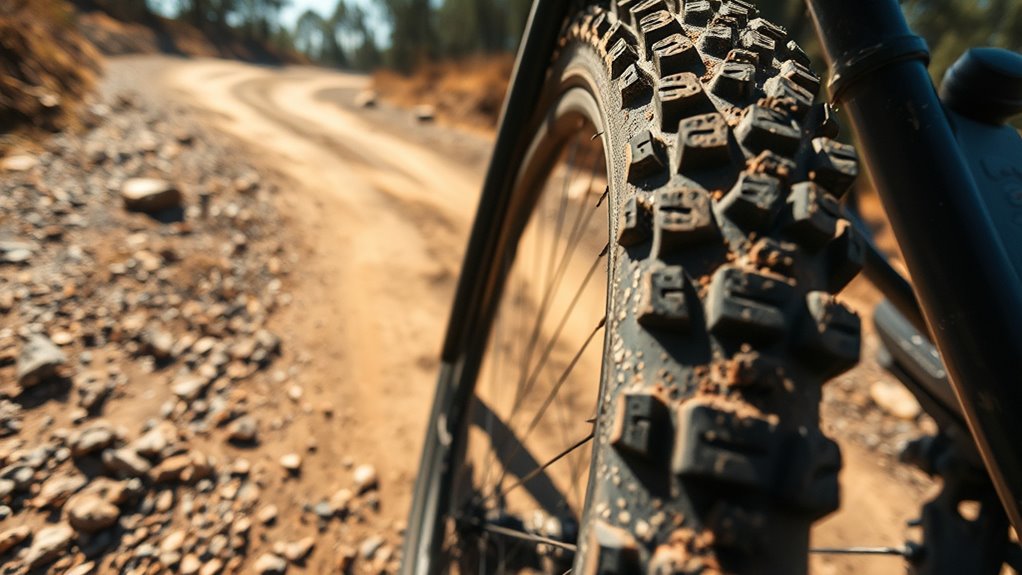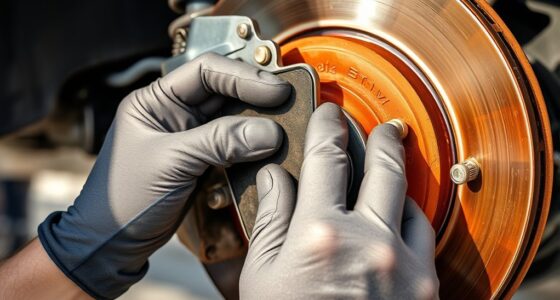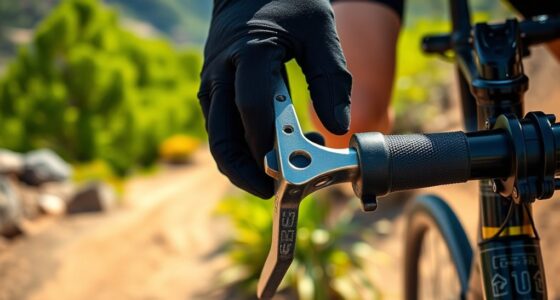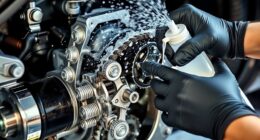For ideal safety and performance, adjust your tire pressure based on your surface: follow your vehicle or bike manufacturer’s recommendations for roads, slightly lower on gravel to improve traction, and reduce pressure further on mountain biking trails to increase grip and shock absorption. Proper inflation prevents flats, improves handling, and maximizes comfort across all terrains. By understanding these basics, you can guarantee a smoother, safer ride—learn more about how to fine-tune your pressure for each surface.
Key Takeaways
- Maintain recommended tire pressures for each surface: higher for roads, slightly lower for gravel, and lower for mountain biking.
- Regularly check and adjust tire pressure based on terrain, rider weight, and conditions for optimal control and comfort.
- Proper inflation enhances safety, traction, and tire lifespan across paved, loose, and rugged terrains.
- Use portable pumps or pressure gauges to ensure accurate tire pressure maintenance before rides or drives.
- Adjust tire pressure to prevent flats, improve grip, and optimize ride quality specific to road, gravel, or MTB surfaces.

Have you ever wondered why maintaining proper tire pressure is essential for your vehicle? It’s because tire pressure management directly impacts your ride quality, safety, and how efficiently your vehicle performs. When your tires are inflated correctly, you achieve optimal inflation, which means your tires can grip the road better, wear evenly, and help you save fuel. Conversely, under-inflated or over-inflated tires can lead to decreased handling, increased tire wear, and even dangerous blowouts. Knowing the right pressure for different surfaces, like road, gravel, or mountain biking, is crucial to maximize your ride experience.
Maintaining proper tire pressure improves safety, handling, and fuel efficiency across all surfaces.
On paved roads, maintaining the correct tire pressure is straightforward but vital. Your vehicle’s manufacturer recommends a specific pressure, often listed on the door frame or in the owner’s manual. By keeping your tires at this optimal inflation, you ensure a smoother ride, better steering response, and improved fuel efficiency. Over time, tires naturally lose pressure, especially with temperature changes. Regularly checking and adjusting your tire pressure helps you stay within the ideal range, preventing uneven wear and potential blowouts. Remember, the pressure listed for your car tires is set for highway conditions, so don’t go below or above that mark unless specified for different loads or speeds.
When you venture onto gravel roads, the importance of tire pressure management becomes even more apparent. Gravel surfaces demand a slightly lower pressure than asphalt to increase the tire’s contact patch. This adjustment provides better traction and absorbs shocks more effectively, giving you more control and comfort. However, going too low can risk tire damage or pinch flats, so it’s essential to know the right balance. Generally, reducing tire pressure by a few PSI from your normal road setting improves your grip on loose surfaces without compromising safety. Always check your tires before hitting gravel, and consider carrying a portable pump to make quick adjustments as needed.
For mountain biking, optimal inflation varies based on terrain, rider weight, and tire design. Lower pressures are typical for MTB tires to maximize traction on uneven, rocky, or muddy trails. Proper tire pressure management in this [scenario] means finding that sweet spot where your tires are soft enough to grip rugged terrain but firm enough to avoid pinch flats. You’ll want to experiment with slight adjustments before rides, especially when transitioning from hardpack to softer dirt. A good rule of thumb is to start with the manufacturer’s recommended PSI, then tune it based on trail conditions and personal preference. Regularly checking your tire pressure ensures you’re always riding on the edge of optimal performance, avoiding flats or slips while maintaining control. Additionally, understanding how tire type and drivetrain components interact can help optimize your inflation strategy for different terrains.
In all cases—road, gravel, or MTB—staying attentive to your tire pressure helps you ride safer, more efficiently, and with greater confidence. Proper tire pressure management isn’t just a routine task; it’s a key part of getting the most out of your vehicle or bike.
Frequently Asked Questions
How Does Tire Pressure Affect Bike Handling?
You’ll notice that tire pressure directly impacts your bike handling by affecting stability and cornering grip. When you maintain ideal tire pressure, your bike feels more stable, giving you confidence on various terrains. If your pressure is too low, you risk decreased stability and poor cornering grip, making control harder. Conversely, too high pressure can reduce traction, so adjusting your tire pressure helps you ride smoothly and confidently.
What Are the Signs of Under or Over-Inflated Tires?
Your tires are like a delicate dance partner—too soft or firm, and the rhythm falters. Signs of under-inflation include a soft feel, increased rolling resistance, and frequent flats, while over-inflation makes the ride harsh, reduces grip, and causes a bumpy experience. Regular tire pressure calibration and seasonal pressure adjustments help prevent these issues, ensuring your ride remains smooth and safe. Always check your tires before hitting the road or trails.
How Often Should I Check My Tire Pressure?
You should check your tire pressure at least once a week or before every ride, especially if you ride frequently. Use a reliable tire pressure gauge to get an accurate reading and make sure your tires are inflated to the recommended PSI. Incorporate proper inflation techniques by checking pressure when tires are cold. Regular checks help prevent flats, improve performance, and extend your tires’ lifespan.
Does Tire Pressure Impact Tire Wear?
Tire pressure can dramatically affect tire wear, almost like a wildfire spreading through a forest. When you don’t do regular tire pressure adjustment, uneven tire wear patterns develop, reducing your tire’s lifespan. Properly maintaining your tire pressure guarantees even wear, prolonging your tires’ life and improving performance. Always check and adjust your tire pressure regularly to prevent unnecessary wear and keep your ride smooth and safe.
Can Changing Tire Pressure Improve Cycling Efficiency?
Absolutely, changing your tire pressure can boost your cycling efficiency. Many tire pressure myths suggest higher pressure always equals better performance, but ideal pressure ranges depend on your bike, terrain, and rider weight. By adjusting your tire pressure to suit conditions, you reduce rolling resistance and improve grip, making your ride smoother and faster. Experiment within recommended ranges to find what maximizes your efficiency without compromising comfort or safety.
Conclusion
As you roll along the winding road, feel the smooth glide of perfectly inflated tires beneath you. Whether you’re conquering gravel trails or mountain climbs, maintaining the right pressure keeps your ride steady and responsive. Imagine the thrill of each turn, the crisp grip on every surface, and the effortless flow of your journey. Keep your tires just right, and every mile becomes a seamless adventure, inviting you to explore further with confidence and ease.









